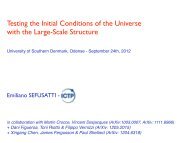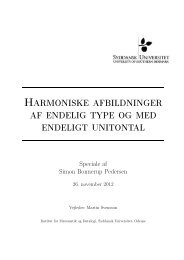A high-resolution version for printing - CP3-Origins
A high-resolution version for printing - CP3-Origins
A high-resolution version for printing - CP3-Origins
You also want an ePaper? Increase the reach of your titles
YUMPU automatically turns print PDFs into web optimized ePapers that Google loves.
This part of the workplan has multiple purposes: it will lead to a deeper understanding of the<br />
Origin of Mass, both theoretically and phenomenologically; it allows us to get closer to cosmology<br />
by direct investigation of models of Dark Matter and baryogenesis; it will lead to a better<br />
understanding of the LHC complex phenomenology and its possible outcomes. In the long run,<br />
and depending on the LHC outcome, we will also explore how these models may fit in a more<br />
unified theory of all <strong>for</strong>ces, including gravity. One can envision, <strong>for</strong> example, the possibility of<br />
marrying supersymmetry and technicolor at a scale <strong>high</strong>er than the electroweak.<br />
Flavour Physics<br />
The goal of this project is to help uncovering an underlying and more fundamental flavour<br />
structure of the SM. This will help guiding our intuition <strong>for</strong> constructing more solid extensions<br />
of the SM.<br />
Perturbed S3 neutrinos<br />
We studied the effects of the perturbation which violates the permutation symmetry of three<br />
Majorana neutrinos but preserves the well known (23) interchange symmetry. This is done in<br />
the presence of an arbitrary Majorana phase which serves to insure the degeneracy of the three<br />
neutrinos at the unperturbed level.<br />
[Perturbed S(3) neutrinos. Renata Jora, (Barcelona, Autonoma U.) , Joseph Schechter, M. Naeem Shahid,<br />
(Southern Denmark U., <strong>CP3</strong>-<strong>Origins</strong> & Syracuse U.). <strong>CP3</strong>-ORIGINS-2009-12, SU-4252-898,<br />
Phys.Rev.D80:093007,2009.]<br />
Discrete Minimal Flavour Violation<br />
We investigated the consequences of replacing the global flavour symmetry of Minimal Flavour<br />
Violation (MFV) SU(3)_QxSU(3)_UxSU(3)_Dx..., by a discrete D_QxD_UxD_Dx.. symmetry.<br />
Goldstone bosons resulting from the breaking of the flavour symmetry generically lead to<br />
bounds on new flavour structure many orders of magnitude above the TeV-scale. The absence of<br />
Goldstone bosons <strong>for</strong> discrete symmetries constituted the primary motivation of our work. Less<br />
symmetry implies further invariants and renders the mass flavour basis trans<strong>for</strong>mation observable<br />
in principle and calls <strong>for</strong> a hierarchy in the Yukawa matrix expansion. We showed, through<br />
the dimension of the representations, that the (discrete) symmetry in principle does allow <strong>for</strong><br />
additional Delta F = 2 operators.<br />
[On discrete Minimal Flavour Violation.<br />
Roman Zwicky, Thomas Fischbacher, (Southampton U.) Published in Phys.Rev.D80:076009,2009.]<br />
In the future we plan to further investigate the flavour structure stemming out from technicolor<br />
type extensions of the SM.<br />
Matter-Antimatter Asymmetry<br />
The matter-antimatter asymmetry, namely the violation of the discrete CP symmetry, is a phenomenon<br />
intimately linked to the origin of fermion masses.<br />
A better characterisation and understanding of CP violation would help in our quest to go beyond<br />
the SM. CP is violated by weak interactions. The SM does not explain this violation, but<br />
successfully accounts <strong>for</strong> it under the <strong>for</strong>m of a phase in the quark mixing matrix.<br />
CP³-Black book 14








